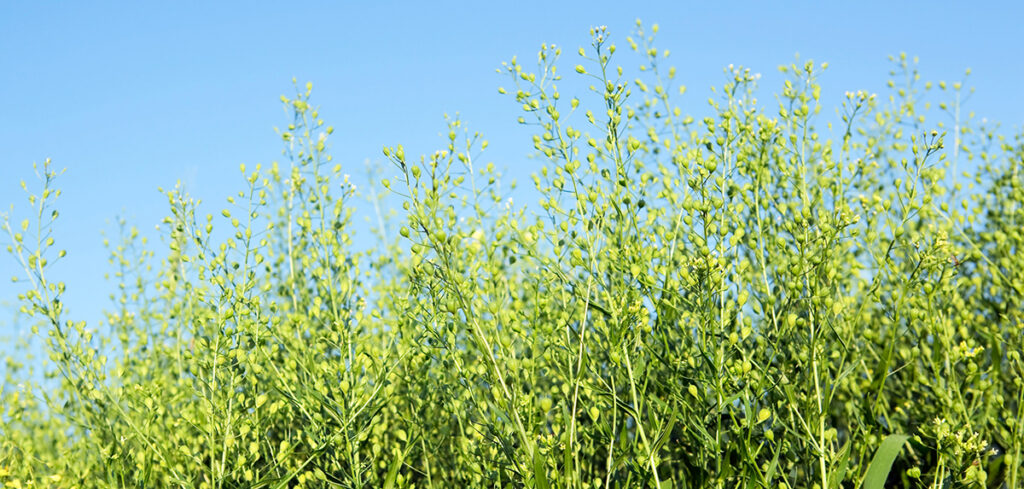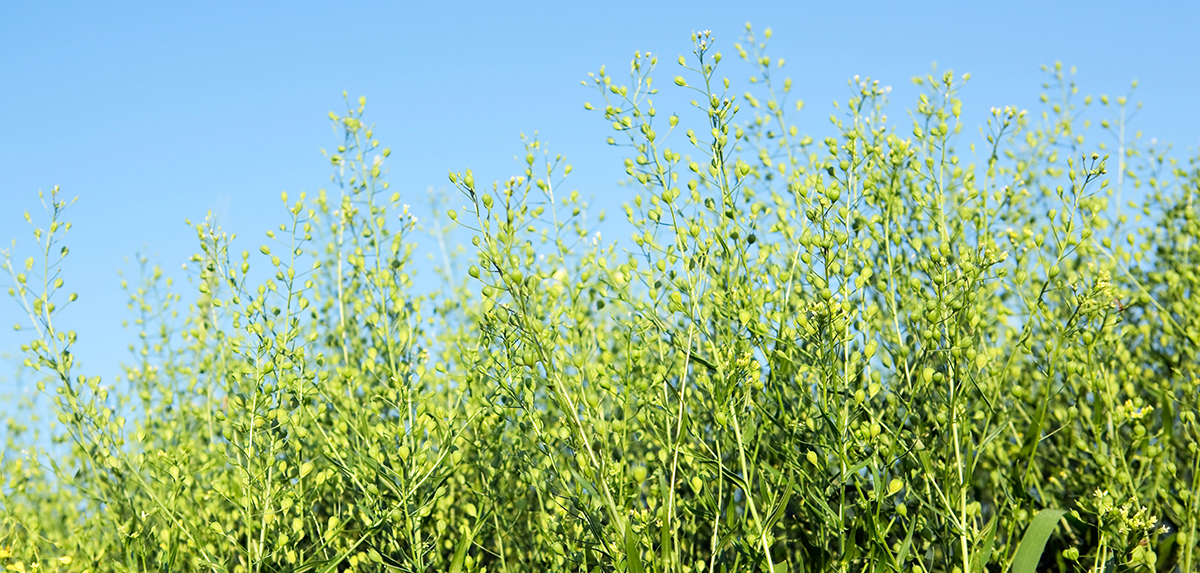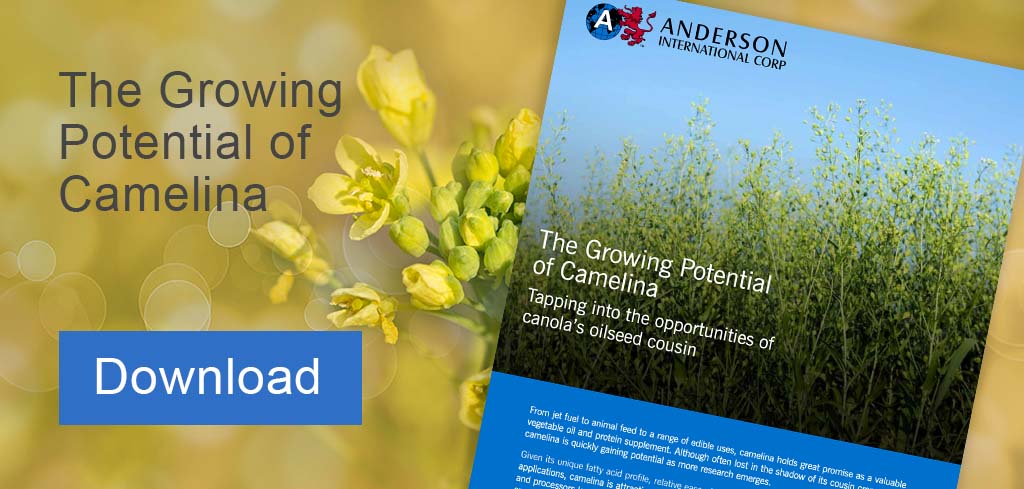
Although its history dates back thousands of years to the Bronze Age, camelina is considered a relatively recent oilseed as its commercial uses are just now being discovered. Showing great potential in terms of agronomic and economic value, this novel crop is rapidly gaining traction as producers discover camelina oil’s many benefits and applications.
While most of the interest in camelina oil comes from its role in biodiesel production, the unique properties of this seed also make it valuable in markets ranging from human food to animal feed. With many unknown factors still surrounding this crop, producers and processors are quickly uncovering new opportunities associated with growing camelina.
Growing camelina
As a member of the Brassica (mustard) family, camelina is closely related to crops like cabbage, cauliflower, and canola. Also known as “false flax” or “gold-of-pleasure,” it even resembles canola with its yellow flowers that produce small, oil-rich seeds.
First produced thousands of years ago in Northern Europe, camelina oil was originally used as food, medicine, and lamp fuel. It was grown widely until the 1940s, but after World War II, camelina production was suddenly replaced by higher-yielding commodity oilseed crops like rapeseed (and later canola.) It wasn’t until 1996 that camelina’s potential as an industrial oilseed crop revived its relevance.
Since then, growing trials across North America have uncovered several advantages of camelina when compared to other crops, including:
- Frost resistance: A cold-hardy, cool-season plant, camelina can be planted in early spring before many other crops. Seeds can germinate in temperatures as low as 34 degrees Fahrenheit, and seedlings have been known to survive temps as cold as 12 degrees Fahrenheit.
- Drought tolerance: Camelina grows well in arid dryland regions in the northern U.S., such as Montana, Wyoming, Oregon, and Washington. The crop can thrive with as little as 11 inches of rainfall, although yields increase with 18-20 inches or more of precipitation.
- Minimal inputs: Compared to other crops, camelina requires fewer agricultural inputs such as water, fertilizer, pesticides, and herbicides. It resists most insects and diseases that afflict canola and other Brassica crops, and it naturally suppresses most weeds without any added chemicals.
- Short growing season: Camelina reaches maturity in less than 100 days. The crop’s short growing season means it can be rotated with other crops like soybean, wheat, and sunflower—giving farmers two harvests in a single year.
These agronomic benefits make camelina relatively easy and inexpensive to grow, offering farmers a good source of economic diversification.
Processing camelina oil
Since camelina is generally produced on a smaller scale than commodity oilseed crops like soybean or canola, mechanical oil pressing is the most common extraction method. Compared to large-scale oil plants that can afford to invest in costly chemical extraction, mechanical pressing offers a low-cost solution for reaping the profits of camelina oil.
Like any oilseed, camelina must be cleaned and dried after harvest to preserve the quality of the seed until it’s pressed. Camelina seeds contain 30-40% oil by weight and about 30% protein, which makes both the oil and the meal valuable byproducts when processed properly.
Camelina seeds are incredibly small, measuring less than 1/16 of an inch. Its tiny size can make camelina challenging to process, so it’s imperative to invest in quality equipment that won’t let the small seeds leak through cracks or gaps.
A screw press like the Anderson Super Duo™ Series Expeller® uses mechanical pressure to squeeze the oil from the camelina seeds, leaving the rest of the solid meal behind. This extraction method typically recovers about 75% of the camelina oil.
To maximize oil recovery, processors can add dry extrusion. A machine like the Anderson Dox™ Extruder efficiently shears, cooks, and dries the seeds using efficient, cost-effective mechanical energy. This creates a high-pressure, high-temperature environment that tears the seeds apart to release more of the oil trapped inside—reducing residual oil to less than 6%.
Read more: Capitalizing on Specialty Oils and Fats with the Anderson Super Duo
Camelina oil applications
The unique properties of camelina oil and meal make both products useful across various industry applications. Although new uses are constantly being discovered and developed, here are some of the most popular camelina products on the market today.
Camelina biodiesel
The biggest driver of camelina oil’s growing demand is its use in the production of renewable biodiesel and bio-jet fuel. Compared to other diesel feedstock crops, camelina has one of the lowest carbon scores, with studies showing it can reduce greenhouse gas emissions by up to 60% compared to petroleum fuel. In fact, the U.S. Air Force has blended camelina biodiesel with standard jet fuel to test fly several fighter jets.
Edible oil
Camelina oil is rich in omega-3 fatty acids and unsaturated fatty acids, making it a heart-healthy edible oil. It can be eaten raw or used for cooking or frying thanks to its high smoke point. It also contains vitamin E, which acts as an antioxidant when ingested and a moisturizer when applied topically to the skin. Vitamin E also improves the stability of camelina oil, giving it a shelf life of more than a year—whereas other omega-3 rich oils like flaxseed can turn rancid within a month.
Animal feed rations
After camelina oil is pressed out of the seeds, the solid meal that remains offers a nutritional source of protein, similar to soybean meal. However, like other members of the mustard family, camelina contains erucic acid and glucosinolates—making the meal unpalatably bitter and even blocking the uptake of certain nutrients, which can be harmful to animal health.
For that reason, camelina meal’s use in animal feed rations was dubious until very recently, when the U.S. Food and Drug Administration (FDA) okayed its inclusion in limited amounts. Currently, the FDA allows 10% camelina meal by weight in beef cattle and poultry feed, and 2% in swine feed rations.
Tapping into the potential
Easy to produce and efficient to process, camelina oil offers huge opportunities to serve a variety of growing markets. As the demand increases for renewable fuel sources, heart-healthy oils, and plant-based proteins, this crop’s potential is set to explode.
While more uses for camelina continue to emerge, processors can position themselves for growth by tapping into the potential of this valuable oilseed now. From the processors’ perspective, camelina shares some similarities with other oilseeds but also presents new problems.
Anderson International understands these commonalities and challenges innately, with decades of experience guiding processors through industry shifts and changes. Building on this strong history, Anderson can provide both the expertise and the equipment processors need to be successful in the emerging camelina market.
To learn more about the opportunities this oilseed offers, contact an Anderson International Representative today.

